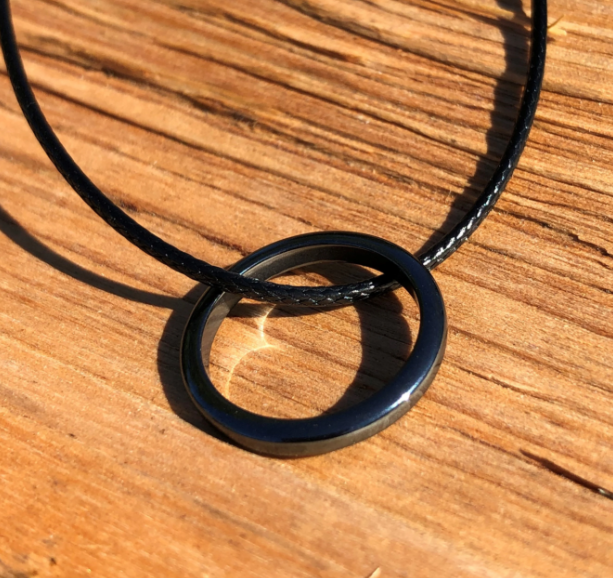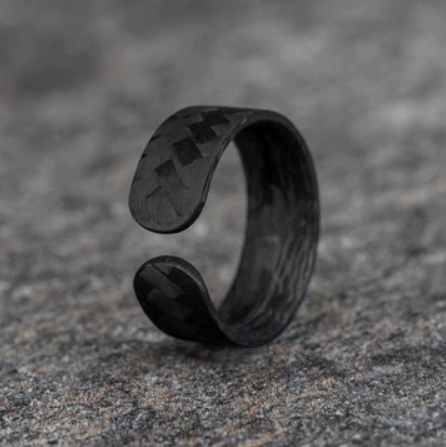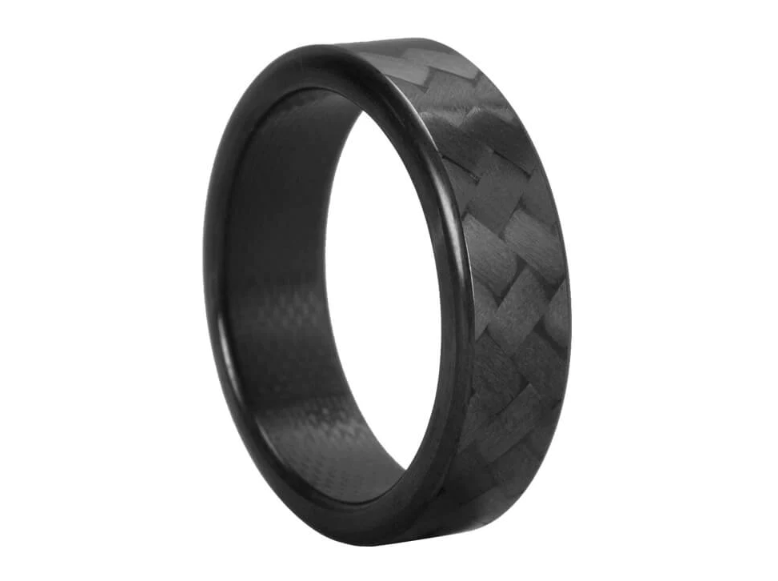In the ever-evolving world of fashion and jewelry, materials that were once limited to high-tech and industrial applications are finding their way into the limelight of personal adornment.
One such material is carbon fiber—a robust, lightweight substance known for its unique appearance and unparalleled strength.
Traditionally associated with aerospace, automotive, and sporting industries, carbon fiber is now catching the eye of jewelers and fashion enthusiasts alike. But does it truly belong in the world of rings, necklaces, and bracelets?
In this article, we will delve into the properties of carbon fiber and evaluate its suitability for jewelry-making. We’ll also weigh its aesthetic and functional merits against more traditional materials.
Whether you’re a jeweler, a fashion enthusiast, or simply curious, read on to explore the potential of this innovative material in the realm of jewelry.
The Characteristics of Carbon Fiber
What exactly is carbon fiber, and what makes it special? Below, we delve into the characteristics of carbon fiber to understand its potential as a choice for jewelry.
Composition and Structure
1. Made of carbon atoms: Carbon fiber is primarily composed of carbon atoms aligned in a crystalline formation. These carbon atoms bond together in microscopic crystals which are more or less aligned parallel to the fiber’s long axis.
2. Strong and lightweight structure: One of the most celebrated features of carbon fiber is its strength-to-weight ratio. Despite being incredibly lightweight, it has a strength that often surpasses that of many traditional materials. This is due to its specific crystalline structure and the tight bonding of the carbon atoms.
3. Layered configuration: Carbon fibers are typically combined with other materials to form composites. The individual fibers are woven in a weave pattern, further enhancing its overall strength and flexibility.
4. Heat conductivity: Despite being an excellent conductor of heat, carbon fiber remains relatively cool to the touch, unlike metals which can become hot under direct sunlight or when subjected to heat.
Durability and Resilience
1. Resistance to corrosion and chemicals: One of the reasons carbon fiber stands out in applications across various industries is its corrosion resistance. Unlike metals which can rust or tarnish over time, especially in the presence of moisture and certain chemicals, carbon fiber remains unaffected. This property makes it especially valuable in jewelry, where the material constantly contacts the skin and is exposed to various environmental factors.
2. High tensile strength: Tensile strength refers to the resistance of a material to breaking under tension. Carbon fiber has a remarkably high tensile strength, which means it can withstand a lot of pull or stress before breaking. This makes it an ideal material for jewelry items that might be subject to strain or stress.
3. UV resistance: Carbon fiber is resilient to the harmful effects of ultraviolet (UV) radiation. Over time, many materials can fade or become brittle when exposed to the sun. However, carbon fiber retains its integrity and appearance, making it an excellent choice for jewelry that might be worn outdoors frequently.
4. Low thermal expansion: Materials usually expand and contract with temperature fluctuations. Carbon fiber has a low coefficient of thermal expansion. This means its shape and size remain relatively consistent regardless of temperature changes. A piece will stay tight enough for jewelry wearers due to temperature variations.
The unique characteristics of carbon fiber, from its composition to its durability, make it an exciting choice for jewelry. Its high resilience and strength combined with its lightweight nature can create stunning, long-lasting pieces that stand the test of time.
Advantages of Carbon Fiber in Jewelry
In this section, we’ll delve into the many advantages of incorporating carbon fiber into jewelry pieces.
Lightweight Nature
- Comfort for wearers: One of the most significant benefits of carbon fiber jewelry is its lightweight nature. This makes it exceptionally comfortable to wear, even for extended periods. Wearers don’t have to worry about the jewelry weighing them down or causing any discomfort.
- Larger designs without the added weight: Designers can experiment with bold and elaborate designs without the concern of making the piece too heavy for wearers. This freedom in design allows for more intricate and expansive pieces, providing both style and comfort.
Unique Aesthetics
- Modern and sleek appearance: Carbon fiber offers a contemporary look, characterized by its distinctive weave pattern and glossy finish. It’s perfect for those seeking a modern and sophisticated aesthetic in their jewelry.
- Versatility in pairing with other materials: Carbon fiber’s neutral color and texture make it a versatile choice, easily paired with traditional jewelry materials like gold, silver, and an array of gems. This blending of materials can result in truly unique and eye-catching pieces.
Hypoallergenic Properties
- Suitable for those with metal allergies: For those who experience allergic reactions to certain metals, carbon fiber offers a safe alternative. Its hypoallergenic properties mean that it won’t cause skin irritations or allergic reactions.
Resistance to Tarnishing and Corrosion
- Minimal maintenance required: Unlike some metals that tarnish over time, carbon fiber retains its appearance without the need for frequent polishing or cleaning.
- Long-lasting shine and appearance: The material’s inherent resistance to corrosion ensures that jewelry pieces maintain their shine and overall appearance for years, making carbon fiber jewelry a worthy investment.
Environmentally Friendly Production
- Less wasteful and toxic than some traditional jewelry production methods: Carbon fiber production can be more environmentally friendly when compared to some metal extraction and refinement processes.
Reduced waste and the absence of toxic chemicals commonly associated with metal jewelry production make carbon fiber a greener choice for the eco-conscious consumer.
Concerns and Limitations of Carbon Fiber Jewelry
While carbon fiber is hailed for its distinctive appearance and lightweight properties, especially in industries such as automotive and aerospace, its introduction to the realm of jewelry is still relatively new. As such, while carbon fiber offers a modern and sleek aesthetic for jewelry enthusiasts, there are concerns and limitations to be aware of.
Not as malleable as metals
- Limited to certain designs: Unlike traditional metals like gold, silver, or platinum, carbon fiber doesn’t lend itself to intricate, detailed designs or traditional forging methods. Its rigidity and fabric-like nature mean that jewelry makers are restricted to specific shapes and forms.
Difficulty in resizing
- Cannot be easily adjusted like gold or silver rings: If you’ve ever needed to resize a metal ring, you’d know that it’s typically a straightforward process. However, carbon fiber rings cannot be resized easily, so getting the right size from the get-go is imperative.
Relative unfamiliarity in the market
- Fewer artisans and designers specializing in carbon fiber: Since carbon fiber jewelry is a relatively new concept, fewer professionals have the expertise to craft or repair it. This could make finding a specialized artisan more challenging and potentially more expensive.
Potential for scratching or chipping under extreme conditions
- While carbon fiber is known for its strength-to-weight ratio in industrial applications, it is not immune to scratches or chips when exposed to harsh conditions or impacts. This can concern those who are active or rough on their jewelry.
Lack of traditional value
- Unlike gold or diamonds, carbon fiber doesn’t hold intrinsic value. While gold or diamond jewelry can be seen as an investment or heirloom, carbon fiber is valued more for its aesthetic and design rather than its resale or inherent value.
Limited customization options
- Given carbon fiber’s unique properties and fabrication process, metal jewelry might be more amenable to personal customization. For instance, embedding gemstones or engraving might be more challenging.
How to clean carbon fiber jewelry
As with any piece of jewelry, regular cleaning and maintenance are essential to ensure that your carbon fiber jewelry retains its sheen and elegance. If you’ve recently invested in a piece, or are simply curious about its upkeep, here are five methods to safely clean carbon fiber jewelry:
Mild Soapy Water Solution
Materials Needed: Mild dish soap, warm water, soft cloth or soft brush.
Procedure: Mix a few drops of mild dish soap with warm water. Dip the soft cloth or brush into the solution and gently scrub the jewelry to remove dirt and oils. Once cleaned, rinse the jewelry with cold water and dry with a lint-free cloth.
Carbon Fiber Cleaning Kits
Materials Needed: Commercially available carbon fiber cleaning kit.
Procedure: These kits are formulated specifically for cleaning carbon fiber surfaces. They usually come with a cleaner and a protector. Simply follow the instructions provided in the kit, ensuring you don’t apply excessive force that could potentially damage the fiber strands.
Alcohol Wipes
Materials Needed: Isopropyl alcohol or alcohol wipes.
Procedure: Gently wipe the surface of the jewelry with an alcohol wipe. This method is great for removing fingerprints or smudges. Use a soft, lint-free cloth to dry the jewelry properly afterward.
Natural Cleaning Solution (Vinegar and Water)
Materials Needed: White vinegar, water, and a soft cloth.
Procedure: Mix equal parts of water and white vinegar. Dip a soft cloth into the solution and gently clean the jewelry. Afterward, rinse with cold water and dry with a lint-free cloth. Vinegar is a gentle cleaning agent that can help remove light stains and maintain shine.
Polishing with Microfiber Cloth
Materials Needed: Microfiber cloth.
Procedure: Even without any cleaning solutions, a soft microfiber cloth can be used to maintain the shine and finish of your carbon fiber jewelry. Gently polish the piece in circular motions, ensuring you don’t press too hard. This can remove fingerprints, smudges, and other light blemishes.
Note: Always avoid using harsh chemicals or abrasive materials on carbon fiber jewelry, as these can damage the surface or compromise the structural integrity of the fibers.
Carbon fiber jewelry requires special attention when cleaning with its unique properties and aesthetic appeal. By following the methods above, you’ll ensure the longevity and beauty of your carbon fiber pieces.

How to safely store carbon jewelry
Proper storage can not only protect your precious carbon jewelry but can also extend its lifespan. Below, we’ve listed five essential methods for safely storing carbon jewelry.
1. Soft Pouch or Jewelry Box
The simplest yet most effective way to store your carbon jewelry is in a soft pouch or jewelry box. These containers protect the jewelry from dust, moisture, and potential scratches. When selecting a pouch or box, opt for one with a soft, non-abrasive lining, such as felt or velvet, to ensure the carbon surface remains unscratched.
2. Avoid Direct Sunlight
Prolonged exposure to direct sunlight can lead to the discoloration of the resin used in some carbon jewelry pieces. To maintain the vibrant and original color of your carbon jewelry, store it in a cool, dark place away from direct sunlight.
3. Humidity Control
Excess moisture can affect the resin components in carbon jewelry, causing them to deteriorate over time. If you live in a humid environment, consider storing your carbon jewelry in a controlled environment. Silica gel packets, which absorb moisture, can be placed in the storage container to help regulate humidity levels.
4. Keep Away from Chemicals
Chemical substances like perfumes, lotions, or cleaning agents can react with the resin in carbon jewelry, leading to discoloration or degradation. Always store your jewelry away from areas where chemicals are frequently used, such as bathrooms or kitchens. Additionally, putting on your carbon jewelry after applying any lotions or perfumes is a good habit.
5. Regular Cleaning
While this isn’t a storage method per se, ensuring your carbon jewelry is clean before storing it can prolong its lifespan. Using a soft cloth and lukewarm water, gently clean your jewelry to remove any oils, dust, or residues. Ensure it’s completely dry before storing it to prevent any potential moisture damage.
While carbon fiber is a durable material well-suited for jewelry, it requires some storage care to maintain its pristine appearance and structure. By following the above guidelines, you can ensure that your carbon jewelry remains in top condition for years to come.
How to keep your carbon jewelry from extreme forces or conditions
As much as this material is hailed for its durability and resilience, it’s equally essential to ensure that carbon jewelry is kept safe from extreme forces and conditions that could affect its appearance or integrity. Here are five detailed methods to help maintain the beauty and longevity of your carbon jewelry.
1. Avoid Direct Impact
Just like any other jewelry, direct impact, such as dropping or knocking against hard surfaces, can cause scratches, dents, or even breakage.
Store your carbon jewelry in a padded jewelry box when not wearing it. Also, leaving your carbon jewelry behind is a good idea if you’re engaged in activities involving potential knocks (like sports).
2. Limit Exposure to Chemicals
Chemicals found in cosmetics, perfumes, and even cleaning products can have adverse reactions with carbon fiber, potentially damaging the finish or weakening the fiber.
Apply perfumes or lotions before putting on your jewelry. Also, remove carbon jewelry before cleaning, swimming in chlorinated water, or any activity where it might come into contact with harsh chemicals.
3. Guard Against Extreme Temperatures
While carbon fiber can endure varying temperatures, prolonged exposure to extremes, especially heat, can cause the resin in carbon fiber to soften or degrade.
Do not leave your jewelry in places like a car dashboard on a sunny day. Keep your carbon jewelry away if you’re using hairstyling tools or attending events with fire or heavy lighting.
4. Regular Cleaning
Dirt and oils from the skin can accumulate on the jewelry over time. While carbon fiber is corrosion-resistant, the accumulated grime can make it lose its shine and look dull.
Use a soft cloth with a mixture of mild soap and water to gently clean your carbon jewelry. Ensure you dry it thoroughly afterward. Avoid using abrasive materials or chemical cleaners.
5. Annual Professional Check
With frequent wear, it’s a good practice to have your carbon jewelry checked by a professional annually. They can assess any potential damage, or wear, or even reapply protective finishes if necessary.
Find a jeweler familiar with carbon fiber materials and treatments. This ensures that your jewelry gets the best care and maintenance tailored to its unique properties.
While carbon fiber boasts strength and durability, taking these precautions ensures that your carbon jewelry remains pristine for years.

Comparing Carbon Fiber to Traditional Jewelry Materials
Gold, Silver, and Platinum: Pros and Cons vs Carbon Fiber
Weight
- Gold, Silver, and Platinum: These metals are relatively heavy, adding a sense of substance and value to the jewelry. However, this weight can sometimes make jewelry uncomfortable to wear for extended periods.
- Carbon Fiber: Carbon fiber is significantly lighter than these metals, making it more comfortable for long wear. This lightweight nature doesn’t provide the “heft” that some people associate with value, but it adds to the overall comfort.
Durability
- Gold, Silver, and Platinum: While platinum is known for its durability, gold and silver are relatively soft metals prone to scratching and wear over time.
- Carbon Fiber: Extremely durable and resistant to corrosion, carbon fiber doesn’t tarnish or scratch easily, making it a more robust choice for everyday wear.
Appearance
- Gold, Silver, and Platinum: These materials have a classic, timeless appeal and offer a high-shine finish that many people find attractive.
- Carbon Fiber: The material has a modern, sleek appearance, usually in black or dark gray, which some might find limiting. However, it stands out as unique and contemporary.
Price
- Gold, Silver, and Platinum: These precious metals are expensive and can significantly add to the overall cost of the jewelry.
- Carbon Fiber: Generally less expensive than precious metals, carbon fiber offers an affordable yet stylish option.
Allergies
- Gold, Silver, and Platinum: Some people are allergic to metals like nickel commonly alloyed with gold and silver, which can cause skin irritation.
- Carbon Fiber: Carbon fiber is hypoallergenic, making it suitable for those with sensitive skin.
Gemstones and their Compatibility with Carbon Fiber
Color Matching
- Gemstones: Gemstones come in a variety of colors, which can be matched well with the classic tones of gold, silver, and platinum.
- Carbon Fiber: The dark tones of carbon fiber offer a high contrast with most gemstones, making the colors pop and look even more vibrant.
Setting Strength
- Gemstones: Traditional settings in gold, silver, or platinum can securely hold a gemstone but might require periodic maintenance.
- Carbon Fiber: The lightweight yet strong nature of carbon fiber allows for secure settings that require minimal maintenance.
Aesthetic Appeal
- Gemstones: When set in traditional metals, gemstones offer a classic look that is universally recognized and appreciated.
- Carbon Fiber: The combination of gemstones and carbon fiber provides a modern and futuristic aesthetic that stands out as unique.
Versatility
- Gemstones: They are extremely versatile and can be set into a variety of metals to suit many styles and occasions.
- Carbon Fiber: While it may not offer the same range of styles as traditional metals, carbon fiber’s unique look gives it a specialized appeal.
Customization
- Gemstones: Traditional metals can be easily molded and customized to fit different sizes and shapes of gemstones.
- Carbon Fiber: The material is also adaptable to customization but may require specialized tools and expertise, making it potentially more challenging for intricate designs.
Conclusion
In the realm of modern jewelry design, carbon fiber has emerged as a notable and innovative material. Its unique aesthetic, characterized by its sleek and contemporary look, offers jewelry enthusiasts a departure from traditional metal-based pieces. Beyond aesthetics, carbon fiber is lauded for its durability, lightweight nature, and resistance to tarnish and corrosion—qualities that are particularly appealing for items that may experience daily wear and tear.
However, like all materials, it has its limitations. Its rigidity, for instance, means it needs to have the malleability of metals, which could limit design intricacies. Additionally, while it is strong, it can be susceptible to scratches, particularly when compared to some metals and gemstones.
When evaluating its suitability, the verdict is largely subjective and depends on individual preference. Carbon fiber is an attractive option for those seeking a modern, lightweight, and distinctive accessory.
For traditionalists or those who prize the shine and weight of precious metals, it might not replace the classics. In the ever-evolving world of jewelry, carbon fiber holds its own niche, complementing, rather than replacing, age-old materials and traditions.



